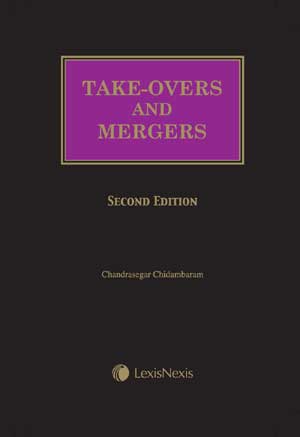
Takeovers and Mergers (2nd Edition) By Chandrasegar Chidambaram
Contrary to the impression conveyed by the title, this book is actually the author’s third foray into the realm of takeovers and mergers. Mr Chandrasegar’s first published work in the area was Corporate Take-overs in the United Kingdom, Singapore and Hong Kong, which appeared more than two decades ago in 1988. The author was at that time working in a firm of solicitors in Hong Kong, having previously joined a leading London law firm. This multi-jurisdictional experience gives him a unique authority to expound the law and practice of takeovers and mergers in Singapore.
The first edition of Takeovers and Mergers was published in 1995, stating the law as it stood at 31 December 1994. This edition is based on the law as it was on 30 April 2010. In between, not only did the millennium change but so did the regulatory framework. The Securities and Futures Act was enacted in 2001. The Takeover Code was substantially revised at about the same time. In 2004, came the Competition Act. The landscape at the end of the first decade of the 21st century was significantly different to that of the mid-nineties. This of course necessitated practically a complete rewriting of the original work, the text of which has expanded by about 50 per cent judging by page count alone. It would have been impossible for a practitioner or academic to keep current merely by relying on the first edition and interpolating the regulatory changes. We can only be grateful that the author has taken the time and trouble to properly update the work instead of doing a patch and paste job.
The only chapters that appear substantially similar to the 1st edition are the first two: respectively, “Legal and Economic Background” and “Pre-1974 Scheme”, and what is now Chapter 12 “Compulsory Acquisition of Shares”. This is not to say that the author is content to merely copy bits of the old book. Chapter 12 has clearly been revised and expanded. Even the chapter on the legal and economic background has been revised to take into account the new anti-competition legislation, not just in Singapore but also in the other jurisdictions like the UK. The constant comparison with foreign jurisdictions is in fact one of the strong points of this book. The author draws on his experience to round out the picture, which for the reader is immensely educational and informative.
This is demonstrated, for instance, in the author’s useful comparison of the US and UK models in Chapter 3, “The Regulatory Scheme”. He is not afraid of expressing his view about the advantages of the UK model (which has broadly been adopted in Singapore) as compared to the US model. The interpolation of the author’s observations based on his experience lifts this work above the average. The discussion of “Defensive Tactics Against Hostile Bids” in Chapter 11, for instance, carries the stamp of authority. One hears the voice of an experienced practitioner speaking about the practical matters within the framework of the regulatory scheme.
As befits a book that is aimed not exclusively at lawyers but also at non-lawyers (eg, merchant bankers), it is written clearly and without large dollops of legalese and long quotations from cases. The author commendably explains at the beginning of each chapter (and sometimes at the beginning of parts of chapters) what he will cover. Of interest too are the references to actual cases, not only in Singapore but also in other comparable jurisdictions. Finally, the reader need not be put off by the seeming bulk of the work; the latter half consists of appendices reproducing the major regulatory provisions. Of particular interest to practitioners are the precedents for various documents found in Appendix C.
All in all, I can recommend this book without reservation. No one who is involved in the the complex business of takeovers and mergers should be without it.
Professor Walter Woon
